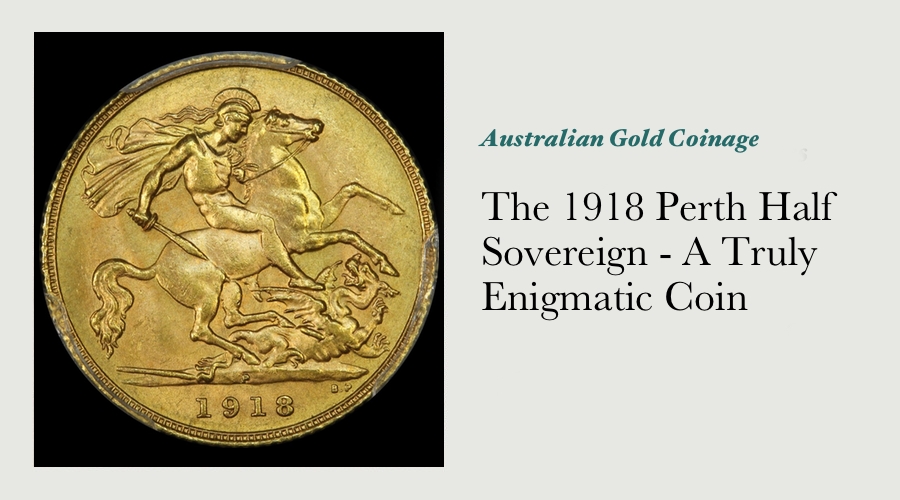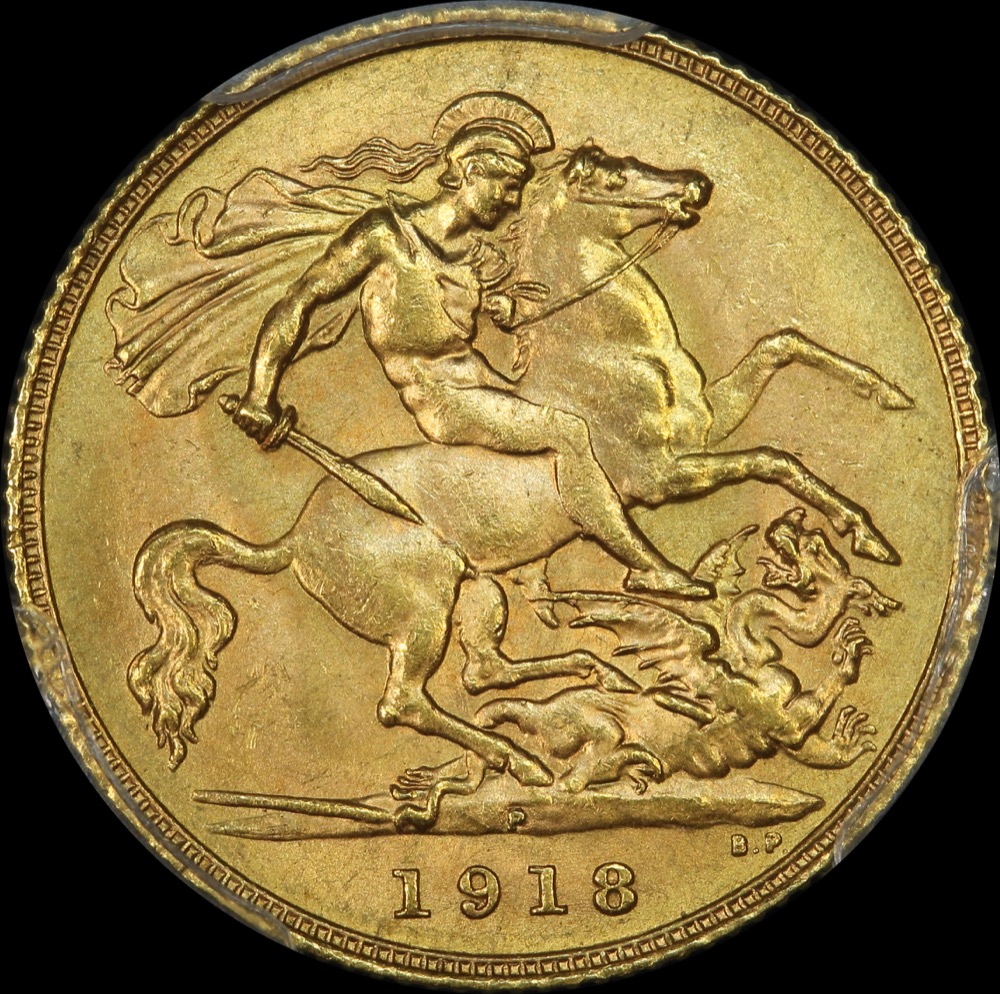The 1918 Perth Half Sovereign - A Truly Enigmatic Coin

The 1918 Perth half sovereign is truly an enigmatic coin - five decades had passed from the date it was made before Australian collectors were able to even confirm that it existed. From the time the first known example was photographed on page 5 of the April 1967 edition of the Australian Coin Review magazine, the exact number struck has been the subject of conjecture. Just what happened to these tiny gold coins once they left the Perth Mint's premises has also been a burning question for many decades.

Several Reasons For Uncertainty Over the Mintage
The primary reason many numismatists have questioned the official mintage figure is the fact that although the Royal Mint prepared half sovereign dies dated 1918 for the Perth Mint, curiously, no half sovereigns were actually struck at the Perth Mint during that calendar year.
Further to that, the Perth Mint Die Register shows that the Royal Mint in London prepared half sovereign dies dated 1920 for the Perth Mint, and also that half sovereigns were struck at the Perth Mint in 1919 and 1920.
A small comment in the "Pocket Guide to Australian Coins and Banknotes" states that "dies dated 1919 and 1920 were prepared", however the Die Register at the Perth Mint does not confirm this. No half sovereign reverse dies were received at all at the Perth Mint during 1919, the Die Register does not indicate that any 1919-dated half sovereign reverse dies were received at all, even if the Royal Mint did prepare them. The Perth Mint Die Register confirms existing knowledge that 1920-dated half sovereign reverse dies were received at the Perth Mint, although they did not arrive until March 3rd, 1920.
In the normal course of business at any branch of the Royal Mint, such a series of facts would strongly indicate that half sovereigns dated 1920 were struck at the Perth Mint, and that none were struck dated 1918. Today's collector market of course instinctively knows that this is not the case, and that a different story must apply.
The pressures imposed upon the Perth Mint staff by World War I meant that the standard practice of the Deputy Master personally observing that all dies used were destroyed at the end of the calendar year were not followed to the letter. Correspondence between the Deputy Master of the Perth Mint and the Deputy Master of the Royal Mint in London on May 7th 1920 shows that the half sovereigns struck at the Perth Mint during 1919 and 1920 were actually struck with dies dated 1918. According to Deputy Master Campbell, this unorthodox measure was necessary once "the confusion caused by the war was experienced, and it was realised how serious the cessation of coinage in wartime would be. The half sovereigns in question were coined at the urgent request of the Commonwealth government..."
Further research into the Perth Mint's archives is required to find out exactly why the Commonwealth Government might have made an "urgent request" for what was a relatively small quantity of half sovereigns.
We can be assured that no half sovereigns dated 1919 or 1920 were struck at the Perth Mint due to a handwritten note attached to the letter from Deputy Master Campbell referred to above: "P.S. Dies telegraphed for in November 1919 were not received until March 1920." A further letter written by Deputy Master Campbell to Deputy Master Cawston on May 14th 1920 stated that: "I note that the Pyx Jury has expressed an opinion against the continuance of the practice, and I have given orders that in future the defacement of the previous year's reverse dies must be carried out immediately after the New Year."
The above statements indicate that unless the Perth Mint half struck half sovereigns between March and December 1920, no half sovereigns dated 1919 or 1920 could ever have been struck at the Perth Mint. The Perth Mint Die Register however shows that each of the then pairs of half sovereign dies used to strike half sovereigns in January 1920 were either cracked or "sunk" (damaged beyond repair by coming into contact with each other) during that production run - no half sovereigns of any date at all are struck after that batch of dies was declared unfit for use by Perth Mint staff. This information should now be conclusive evidence that no half sovereigns dated 1919 or 1920 were ever struck at the Perth Mint.
The Exact Mintage Figure of the 1918 Perth Half Sovereign
The exact mintage figure for the 1918 Perth half sovereign has long been the subject of conjecture, however correct interpretation of archival records at the Perth Mint indicate that the mintage can be calculated as being 219,988 coins:
1919 - 113,572 coins struck (This figure was recorded on page 6 of the Annual Report of the Perth Branch of the Royal Mint for 1919. At this stage, it is known that these coins were struck during December 1919 - the exact dates in December over which this production took place is yet to be determined.)
1920 - 106,416 coins struck (This figure was recorded on page 10 of the Annual Report of the Perth Branch of the Royal Mint for 1920. 40,020 coins were apparently struck on January 21st 1920 and 66,396 coins were struck on January 29th 1920. Despite this, the Die Register shows that these coins were struck between January 17th and January 24th, production ceased when the last dies were rendered unfit for operation.
Total Mintage - 219,988 coins.
What Happened to the 1918 Perth Half Sovereigns Once They Left The Perth Mint?
Experienced collectors of Australian gold coins will be well aware that this figure is far higher than the market rarity of this coin might suggest. Just what happened to the 219,988 half sovereigns struck by the Perth Mint between December 1919 and January 1920 once they left the Perth Mint's premises is a question that has puzzled collectors for many decades.
One explanation for the rarity of the 1918 Perth half sovereign considered previously can be found in a comment in the Australian Coin Review article from October 1967 "It is hard to determine whether the half-sovereigns sent overseas from the Perth Mint in 1919 and 1920 were the 1915 issues or issues struck bearing later dates." Recent research into the archives of the Perth Mint has now cleared up this uncertainty.
The Perth Mint Die Register shows that half sovereigns were struck at the Perth Mint in 1915 between August 2nd and 9th, then between October 1st - 4th, then in December (the exact date/s in December are uncertain at this stage). The Coining Department - General Account for 1915 confirms that the number of "Good Coin" half sovereigns struck during 1915 was 136,219 coins. In addition to that fact, Table H. of the 1915 Annual Report shows that 136,219 in half sovereigns were "issued" by the Perth Mint during that calendar year.
This shows that an amount of half sovereigns equivalent to the exact mintage of the 1915 Perth half sovereign was "issued" during 1915. Based on this information, it is not imprudent to assume then that the entire mintage of the 1915 Perth half sovereign was "issued" during 1915, and were not retained for "issue" during later years.
It is known that in April and May of 1919 alone, some £2,000,000 in gold sovereigns was exported from Australia to India, as part of a broader policy by the British Government to concentrate gold reserves in London, while at the same time supporting the Indian export trade. As the 1918 Perth half sovereigns were struck between December 1919 and January 1920, it is clear that they could not possibly have been included as part of that outward consignment of gold coins. It is also known that on March 6th 1919, the Gold Producers' Association was incorporated with the approval of the Commonwealth Government. This Association was formed to obtain additional revenue for the Australian gold mining industry by selling Australian gold overseas, where they were able to obtain a premium over the amount ordinarily obtained in Australia.
Numerous other exports of Australian gold coins occurred during this period however - just where the 1918 Perth half sovereigns were dispatched to is a question that will surely be satisfied with further research. In the meantime, page 6 of the Royal Mint Annual Report for 1919 states that "A considerable amount of the coin and bullion produced at the Perth Branch has, it is understood, been exported in the interests of the Gold Producers' Association. This includes the whole of the half-sovereigns produced and the whole of the "Gold Bullion for Export."
Just whether the Commonwealth Government expressly request that a certain quantity of gold intended for export should be coined into half sovereigns, as opposed to sovereigns or even small ingots, remains to be determined. If the Commonwealth Government did not make this express request, just why Perth Mint staff chose to prepare that quantity of gold in the form of half sovereigns over the other forms mentioned also remains to be determined.
The answer to these questions may shed further light on why the vast majority of the 1918 Perth half sovereigns have never seen the light of day. Whether they were also shipped to India, and remain to this day deep in the vaults of an Indian temple such as this one at Padmanabhaswamy, or whether they were shipped to Great Britain or the United States with the vast majority melted down as soon as they arrived, we are yet to find out.
What is known is that the first example of this coin made it's appearance on page 5 of the April 1967 edition of the Australian Coin Review magazine. Australia's National Coin Collection, stored at and managed by the Royal Australian Mint, also acquired two examples around September 1967. An examination of the available numismatic auction records from the 1970's shows that 1918 Perth half sovereigns were very rare indeed until perhaps the mid to late 1970's. A small article in the Australian Financial Review newspaper dated March 29th 1979 breathlessly discussed the auction of a significant collection of gold coins by Downie's of Melbourne on March 15th & 16th. The description for lot 678 reads as follows:
"Although a few have been unearthed in the last few years, the total number known probably does not exceed 25. A great rarity and internationally important. A little softly struck on St George knee otherwise good EF." Much was made in the AFR of the vendor achieving $775 for the sale of this coin, as well as of the "...$2,800 it had cost its owner Bill Johnson when the coin was rare."
While such a significant percentage drop in value was perhaps newsworthy to a degree, the price realised perhaps was not - various auction results for this coin between 1975 and 1981 indicate that it had traded at anywhere between $445 and $1,600. Although significantly lower than $2,800, $775 sits comfortably within that range.
Despite and perhaps because of the unanswered questions surrounding it, the 1918 Perth half sovereign remains a fascinating, historic and desirable coin. It is sure to remain of interest to Australian coin collectors for many decades to come.